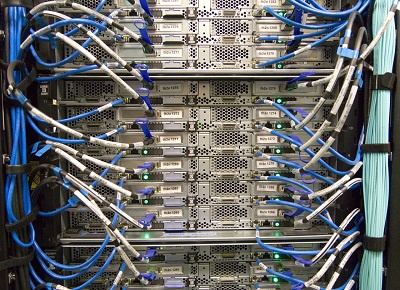A rack server is a type of server that is designed to be mounted in a standard-sized rack, which is a frame that holds multiple servers in a space-efficient manner. Rack servers are typically used in data centers and other IT environments where multiple servers are needed.
Rack servers are usually mounted in a rack using screws or other mounting hardware, and can be easily removed and replaced as needed. They are typically 1U, 2U, or 4U in size, with 1U being the most common. The size of a rack server is measured in units (U), with 1U being equal to 1.75 inches. Rack servers can be stacked on top of each other in a rack to maximize the use of space.
Rack servers are typically used for a variety of purposes, including hosting websites, storing and managing data, running applications, and providing infrastructure services such as networking and storage. They can be purchased from a variety of manufacturers, and come in a range of sizes and configurations to meet the needs of different organizations.
5 Important Types of Equipment
A server rack is a frame that is used to hold and organize servers and other computing equipment in a data center or other IT environment. Here are five important types of equipment that may be found in a server rack:
-
Servers: A server is a computer that is designed to process requests and deliver data to other computers over a network. Server racks typically hold multiple servers, which can be used for a variety of purposes, such as hosting websites, storing and managing data, or running applications.
-
Networking equipment: Networking equipment is used to connect servers and other devices to a network and to the Internet. This can include switches, routers, and firewalls, which help to manage and secure network traffic.
-
Storage devices: Storage devices are used to store data, including files, images, and other types of digital information. These can include hard drives, solid-state drives, and network-attached storage devices.
-
Power distribution units: Power distribution units (PDUs) are used to distribute power to the equipment in the server rack. They typically include outlets for servers and other devices to be plugged into, as well as circuit breakers or other protection mechanisms.
-
Cooling equipment: Cooling equipment is used to keep the servers and other equipment in the server rack from overheating. This can include air conditioning units, fans, and other cooling devices.
In addition to these types of equipment, server racks may also include other types of hardware and infrastructure, such as cables, wiring, and mounting hardware.
Server Rack Sizes: Understanding the Differences
Server racks are typically sized in units (U), with 1U being equal to 1.75 inches. The size of a server rack is determined by the height of the servers and other equipment that will be mounted in it. Here is an overview of common server rack sizes:
-
1U: 1U racks are the most common size and are typically used for small servers or other equipment that does not require a lot of space.
-
2U: 2U racks are slightly larger than 1U racks and are typically used for servers or other equipment that requires more space or has a larger form factor.
-
3U: 3U racks are larger than 1U and 2U racks and are typically used for servers or other equipment that requires even more space or has a larger form factor.
-
4U: 4U racks are the largest common size and are typically used for servers or other equipment that requires a lot of space or has a very large form factor.
In addition to these sizes, server racks may also be available in other sizes, such as 0U, 5U, and 6U, depending on the needs of the organization. It is important to choose the right size server rack to ensure that there is enough space for all of the servers and equipment that will be mounted in it.


No comments yet